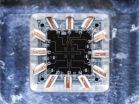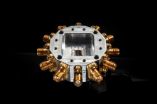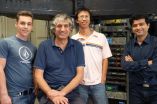(Press-News.org) While the Martinis Lab at UC Santa Barbara has been focusing on quantum computation, former postdoctoral fellow Pedram Roushan and several colleagues have been exploring qubits (quantum bits) for quantum simulation on a smaller scale. Their research appears in the current edition of the journal Nature.
"While we're waiting on quantum computers, there are specific problems from various fields ranging from chemistry to condensed matter that we can address systematically with superconducting qubits," said Roushan, who is now a quantum electronics engineer at Google. "These quantum simulation problems usually demand more control over the qubit system." Earlier this year, John M. Martinis and several members of his UCSB lab joined Google, which established a satellite office at UCSB.
In conjunction with developing a general-purpose quantum computer, Martinis' team worked on a new qubit architecture, which is an essential ingredient for quantum simulation, and allowed them to master the seven parameters necessary for complete control of a two-qubit system. Unlike a classical computer bit with only two possible states -- 0 and 1 -- a qubit can be in either state or a superposition of both at the same time, creating many possibilities of interaction.
One of the crucial specifications -- Roushan refers to them as control knobs or switches -- is the connectivity, which determines whether or not, and how, the two qubits interact. Think of the two qubits as people involved in a conversation. The researchers have been able to control every aspect -- location, content, volume, tone, accent, etc. -- of the communication. In quantum simulation, full control of the system is a holy grail and becomes more difficult to achieve as the size of the system grows.
"There are lots of technological challenges, and hence learnings involved in this project," Roushan said. "The icing on the cake is a demonstration that we chose from topology." Topology, the mathematical study of shapes and spaces, served as a good demonstration of the power of full control of a two-qubit system.
In this work, the team demonstrates a quantum version of Gauss's law. First came the 19th-century Gauss-Bonnet theorem, which relates the total local curvature of the surface of a geometrical object, such as a sphere or a doughnut, to the number of holes in the object (zero for the sphere and one for the doughnut). "Gauss's law in electromagnetism essentially provides the same relation: Measuring curvature on the surface -- in this case, an electric field -- tells you something about what is inside the surface: the charge," Roushan explained.
The novelty of the experiment is how the curvature was measured. Project collaborators at Boston University suggested an ingenious method: sensing the curvature through movement. How local curvature affects the motion can be understood from another analogy with electromagnetism: the Lorentz force law, which says that a charged particle in a magnetic field, which curves the space, is deflected from the straight pass. In their quantum system, the researchers measured the amount of deflection along one meridian of a sphere's curve and deduced the local curvature from that.
"When you think about it, it is pretty amazing," Roushan said. "You do not need to go inside to see what is in there. Moving on the surface tells you all you need to know about what is inside a surface."
This kind of simulation -- arbitrary control over all parameters in a closed system -- contributes to a body of knowledge that is growing, and the paper describing that demonstration is a key step in that direction. "The technology for quantum computing is in its infancy in a sense that it's not fully clear what platform and what architecture we need to develop," Roushan said. "It's like a computer 50 years ago. We need to figure out what material to use for RAM and for the CPU. It's not obvious so we try different architectures and layouts. One could argue that what we've shown is very crucial for coupling qubits when you're asking for a full-fledged quantum computer."
INFORMATION:
Lead co-authors are UCSB's Charles Neill and Yu Chen, of Google Inc., Santa Barbara. Other UCSB co-authors include Rami Barends, Brooks Campbell, Zijun Chen, Ben Chiaro, Andrew N. Cleland, Andrew Dunsworth, Michael Fang, Julian Kelly, Nelson Leung, Anthony Megrant, Josh Mutus, Peter O'Malley, Chris Quintana, Amit Vainsencher, Jim Wenner and Ted White, as well as Evan Jeffrey, Martinis and Daniel Sank of Google Inc., Santa Barbara, and Michael Kolodrubetz and Anatoli Polkovnikov of Boston University.
This work was supported by the National Science Foundation (NSF), the Office of the Director of National Intelligence and the Intelligence Advanced Research Projects Activity. Devices were made at the UCSB Nanofabrication Facility, part of the NSF-funded National Nanotechnology Infrastructure Network and the NanoStructures Cleanroom Facility.
It's not uncommon to see cameras mounted on store ceilings, propped up in public places or placed inside subways, buses and even on the dashboards of cars.
Cameras record our world down to the second. This can be a powerful surveillance tool on the roads and in buildings, but it's surprisingly hard to sift through vast amounts of visual data to find pertinent information - namely, making a split-second identification and understanding a person's actions and behaviors as recorded sequentially by cameras in a variety of locations.
Now, University of Washington electrical ...
ITHACA, N.Y. - Peering deep into time with one of the world's newest, most sophisticated telescopes, astronomers have found a galaxy - AzTEC-3 - that gives birth annually to 500 times the number of suns as the Milky Way galaxy, according to a new Cornell University-led study published Nov. 10 in the Astrophysical Journal.
Lead author Dominik Riechers, Cornell assistant professor of astronomy, and an international team of researchers gazed back - with the Atacama Large Millimeter/submillimeter Array (ALMA) in Chile - over 12.5 billion years to find bustling galaxies creating ...
New York, NY - The female mosquitoes that spread dengue and yellow fever didn't always rely on human blood to nourish their eggs. Their ancestors fed on furrier animals in the forest. But then, thousands of years ago, some of these bloodsuckers made a smart switch: They began biting humans and hitchhiked all over the globe, spreading disease in their wake.
"It was a really good evolutionary move," says Leslie B. Vosshall, the Robin Chemers Neustein Professor and head of the Laboratory of Neurogenetics and Behavior at The Rockefeller University, and a Howard Hughes Medical ...
As cities and incomes increase around the world, so does consumption of refined sugars, refined fats, oils and resource- and land-intense agricultural products such as beef. A new study led by University of Minnesota ecologist David Tilman shows how a shift away from this trajectory and toward healthier traditional Mediterranean, pescatarian or vegetarian diets could not only boost human lifespan and quality of life, but also slash greenhouse gas emissions and save habitat for endangered species.
The study, published in the November 12 online edition of Nature by Tilman ...
Menlo Park, Calif. -- A study at the Department of Energy's SLAC National Accelerator Laboratory suggests for the first time how scientists might deliberately engineer superconductors that work at higher temperatures.
In their report, a team led by SLAC and Stanford University researchers explains why a thin layer of iron selenide superconducts -- carries electricity with 100 percent efficiency -- at much higher temperatures when placed atop another material, which is called STO for its main ingredients strontium, titanium and oxygen.
These findings, described today ...
Graphene is the miracle material of the future. Consisting of a single layer of carbon atoms arranged in a honeycomb lattice, the material is extremely stable, flexible, highly conductive and of particular interest for electronic applications. ETH Professor Tilman Esslinger and his group at the Institute for Quantum Electronics investigate artificial graphene; its honeycomb structure consists not of atoms, but rather of light. The researchers align multiple laser beams in such a way that they create standing waves with a hexagonal pattern. This optical lattice is then superimposed ...
A research team led by Jackson Laboratory Professors Frank McKeon, Ph.D., and Wa Xian, Ph.D., reports on the role of certain lung stem cells in regenerating lungs damaged by disease.
The work, published Nov. 12 in the journal Nature, sheds light on the inner workings of the still-emerging concept of lung regeneration and points to potential therapeutic strategies that harness these lung stem cells.
"The idea that the lung can regenerate has been slow to take hold in the biomedical research community," McKeon says, "in part because of the steady decline that is seen ...
The brain's ability to effectively deal with stress or to lack that ability and be more susceptible to depression, depends on a single protein type in each person's brain, according to a study conducted at the Icahn School of Medicine at Mount Sinai and published November 12 in the journal Nature.
The Mount Sinai study findings challenge the current thinking about depression and the drugs currently used to treat the disorder.
"Our findings are distinct from serotonin and other neurotransmitters previously implicated in depression or resilience against it," says the ...
Not long ago, it would have taken several years to run a high-resolution simulation on a global climate model. But using some of the most powerful supercomputers now available, Lawrence Berkeley National Laboratory (Berkeley Lab) climate scientist Michael Wehner was able to complete a run in just three months.
What he found was that not only were the simulations much closer to actual observations, but the high-resolution models were far better at reproducing intense storms, such as hurricanes and cyclones. The study, "The effect of horizontal resolution on simulation ...
The human immunodeficiency virus (HIV) can insert itself at different locations in the DNA of its human host - and this specific integration site determines how quickly the disease progresses, report researchers at KU Leuven's Laboratory for Molecular Virology and Gene Therapy. The study was published online today in the journal Cell Host & Microbe.
When HIV enters the bloodstream, virus particles bind to and invade human immune cells. HIV then reprogrammes the hijacked cell to make new HIV particles.
The HIV protein integrase plays a key role in this process: it ...






